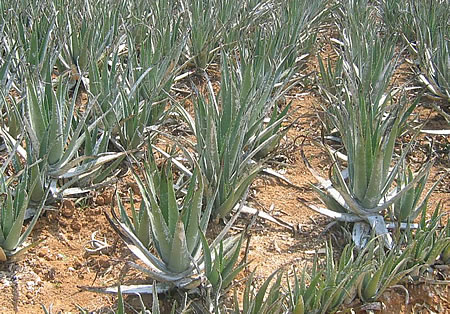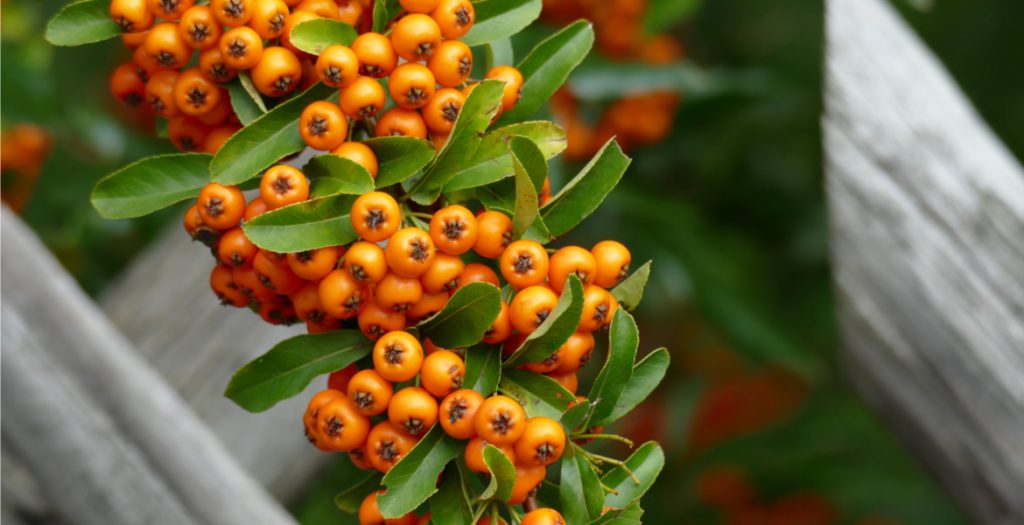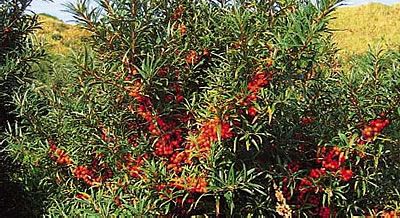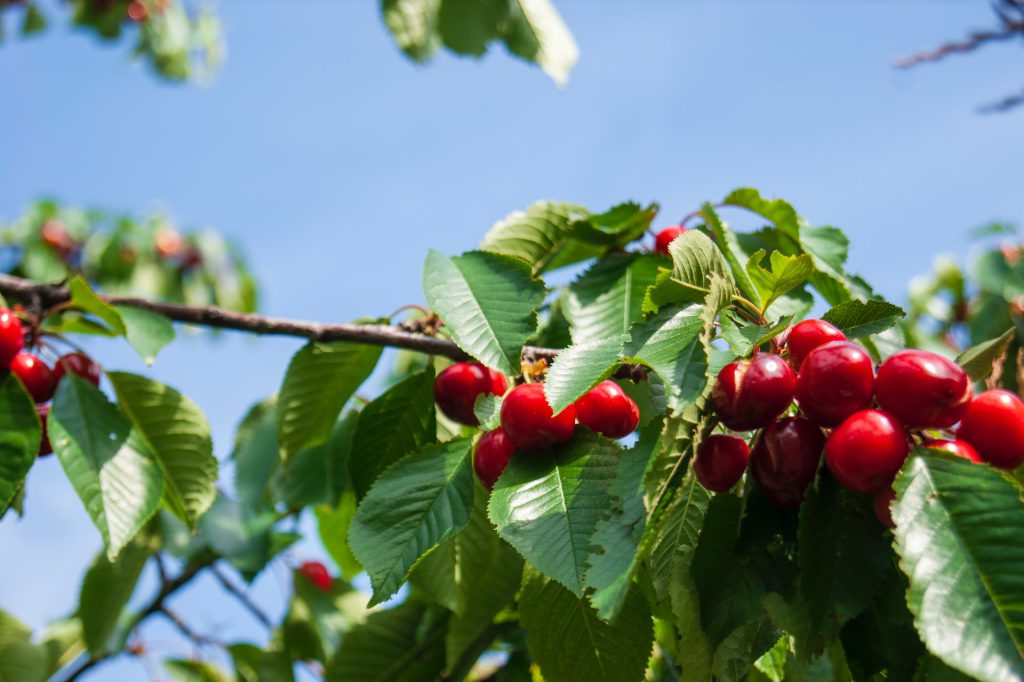Please read carefully this article about how to grow Aloe Vera plants!
Aloe Vera can be grown both in the ground and in pots.
Aloe Vera is a plant that is presented by some as a plant with almost magical properties and by others as an overrated plant whose use carries some risks.
Aloe Vera is a plant with healing properties. It belongs to the family “Xanthorrhoeaceae”, subfamily “Asphodelaceae”, genus “Aloe”. The other species belonging to this category are aloe parvula, aloe peglerae and aloe dichotoma. There are more than 250 species of Aloe. The most useful among them, however, is Aloe Vera. For this reason, Aloe Vera is also called “Aloe the genuine”. Vera, the second synthetic of the species name, means “genuine or true”. Aloe Vera is a native plant of Africa. It is often found in Africa, North America, Egypt, India and Sudan.
Aloe Vera is a succulent, fleshy plant. Like other fleshy plants (such as cactus), it retains a lot of water in its leaves and stem. These plants are able to survive in harsh weather conditions without water. Even in the desert.
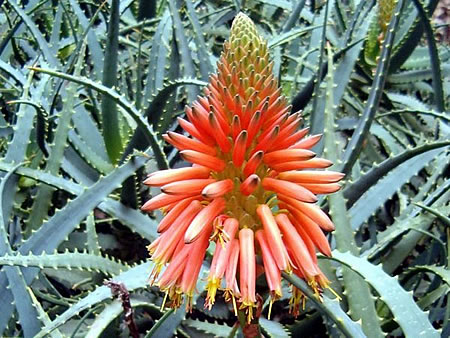
Some of the Aloe Vera plants bloom in summer. The flowers of these plants have long stems and their colour is deep red. The flowers come out from the center of the plant. Many of these plants have no stem at all or the stem is very short. Their leaves are thick and fleshy. The colour of the leaves varies from green to greyish-green. All the leaves of Aloe grow around a common point.
Some varieties of these plants have white spots on the upper and lower surface of their leaves. The periphery of the leaves of the plants is serrated. In Thailand they are known as “crocodile tail” plants, as they resemble a crocodile’s tail.
Aloe Vera is resistant to harmful insects. Since ancient times it has been used as a herbal medicine. It is also used as a flavouring plant (in cooking or as a seasoning).
Aloe Vera is cultivated all over the world because of the importance of its medicinal properties. The care needed for the plant is minimal.
A fungus called “Arbascular Mycorrhiza” grows on the surface of the plant. This fungus enters the plant and helps increase the extraction of potassium and other useful elements from the soil. It is because of this that the plant has such great therapeutic importance.
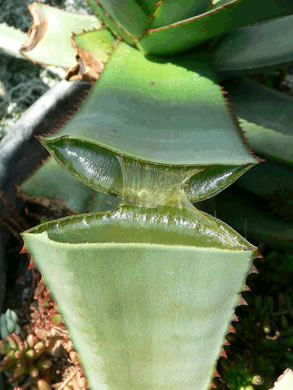
The sticky substance within the leaves of Aloe Vera is called Aloe gel. It contains a high concentration of “Aloe Emodin”, a very powerful laxative that can bring about proper bowel motility. Taken in the morning of each day, it enhances the digestion of food.
Aloe Vera plants are used for commercial purposes. Products such as Aloe Vera shampoos, Aloe Vera gels and Aloe Vera ointments are derived from them. Aloe Vera is used in skin care and acne treatment products. Aloe Vera combined with glycerin is a very good cleansing agent.
Ingredients of Aloe Vera
The following ingredients have been detected in Aloe Vera.
Vitamins
Vitamin A, Vitamin B1, Vitamin B2, Vitamin B2, Vitamin B6, Vitamin B12, Vitamin C, Vitamin E, Folic acid.
Minerals
Calcium, Potassium, Magnesium, Magnesium, Sodium, Copper, Iron, Zinc, Manganese.
Amino acids
Lysine, Threonine, Valine, Methionine, Methionine, Isoleucine, Phenylalanine, Aspartic Acid, Serine, Glutamic Acid, Glycine, Alanine, Tyrosine, Hydroxyproline, Cystine, Leucine.
Enzymes
Oxidase, Catalase, Amylase, Amylase, Bradykinase, Cellulase, Lipase, Alaninase, Phosphatase, Phosphokinase, Phosphokinase Kreatinate, Hydrogenase.
Monosaccharides and Polysaccharides
Accumannan, arabinose, galactose, galactose, glucose, mannose, mannose, rhamnose, xylose, glucoranic acid, galacturonic acid, cytarcin.
Sterols
Cabesterol, Lupeol, Beta-Sitosterol.
Amino Sugars
Glucosamine, Galactosamine.
Fatty Acids
Cholesterol, Cabesterol, Beta-Sitosterol, Lupeol.
Trace elements
Aluminium, Chlorine, Chlorine, Sodium, Sodium, Chromium, Calcium, Iron, Manganese, Magnesium, Sulphur, Copper, Potassium, Phosphorus, Zinc.
In addition, Aloe Vera contains
Lignin, Saponin, Salicylic Acid, Essential Oils, Beta-Carotene, Choline.
Varieties of Aloe
The most important varieties of Aloe are:
- Aloe Barbadensis Miller
- Aloe Saponaria
- Aloe Chine sis
- Aloe chinensis Aloe chinensis Chinensis China Aloe chinensis Chinensis
- Aloe Forex
- Aloe Lalifolia
- Curacao Aloe
The most popular of the above varieties is Aloe Barbadensis Miller which has the greatest therapeutic value and is known as Aloe Vera or Aloe vera.
Cultivation of Aloe Vera
Aloe Vera is cultivated for its leaves and their contents. The gel contained within the leaves is used extensively by the cosmetics industry and alternative medicine.
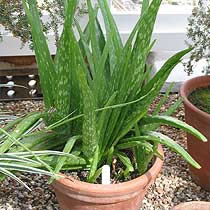
Aloe Vera can be grown both in the ground and in pots.
In the ground, Aloe Vera should be planted in a place where it is exposed to the sun continuously or for many hours a day. It should not be placed in a place that has constant shade.
When grown in pots then you should make sure that in the summer you keep the pots outside in a place where the sun can see it, and in the winter you should put them inside but in a place where the sun can see it.
Climatic requirements
Aloe Vera can only be grown in areas where there are no frosts and very low temperatures in winter. Because the plant is fleshy and is 95% water, frost destroys the plant.
Because Aloe Vera needs sun and little watering, it grows well in arid, dry or semi-arid areas.
Soil
It grows well in soils that are nutrient poor. For commercial cultivation, however, fertile or light sandy soils that are well drained and with a pH of up to 8.5 are preferred.
Soil preparation
The preparation of the soil for growing aloe plants is simple and easy.
It starts with 1 or 2 ploughing operations. The ploughing does not have to be deep. As the root system of Aloe is superficial and grows in width rather than depth, ploughing to a depth of 20 to 30 cm is sufficient.
As with other crops, the time interval between ploughing should be about 2 weeks. Between the first and second ploughing the weeds appear from the seeds contained in the soil. The second ploughing destroys most of them and the soil remains free of weeds. The soil is then straightened.
See also the fertilization topic below.
Planting season
Aloe Vera plants can be planted all year round, except during the winter months (November to February). The planting of the plants is followed by a good watering.
Planting material
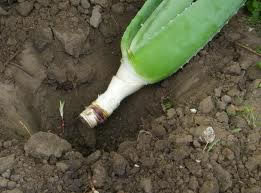
New shoots (offsets) grow around the main Aloe Vera plant. These can be carefully detached, taking care to include as much of the white root as possible. The offsets are planted and give rise to new Aloe Vera plants.
Remove the offset shoots when they have 4 to 5 leaves that reach a length of 20 to 25 centimeters.
In fact, we have to remove the offsets. Otherwise they compete with the parent plant and none of them eventually become robust.
Planting distances
New Aloe plants are planted in rows. The plants in each row are planted 60 centimeters apart. Each row is 60 centimeters apart. In this way, we can plant about 2800 plants per acre.
The offsets are planted at a depth of about 15 cm. Press the soil around the new plant so that it is firmly supported. We water and make sure that the water is absorbed by the soil and does not stagnate.
Fertilizing
In general, Aloe Vera responds positively to the use of manure or compost as fertilizer. Approximately 1 to 1.5 tons of manure or compost per acre can be added during the initial soil preparation phase. Also, additional manure or compost can be added in subsequent years.
However, the plant will still perform well without the use of manure or compost.
Also, if clean wood ash is available during the planting phase, you can add it to the pits during the planting process.
Irrigation and watering
Aloe Vera plants can withstand long periods without watering. However, irrigation during the critical growth phases of the plant is an essential factor in the success of the crop.
The first irrigation should be done immediately after planting. This should be followed by 2 to 3 irrigations until we are sure the plant has taken hold.
Thereafter, only 4 to 6 irrigations per year are required. The soil should be allowed to dry out completely before the next watering.
If water is available, you can lightly water the Aloe Vera after the leaves are cut/harvested. It is not necessary, but it generally helps.
The most common problem that Aloe crops face is over-watering. The symptoms become visible in the form of brown or black spots on the Aloe leaves. If we continue to water then the leaves turn yellow and fall off.
Also when there is over watering, the leaves grow flat and not upwards, which is the normal.
Stop watering if you see such signs.
Clearing the soil of weeds
You should make sure that the soil is clear of weeds. The first removal of weeds and the first hoeing should be done within the first month after planting the plants. In the following years you should ensure that the weeds are removed. Also every year you should do at least two light hoeing sessions. During these operations, you should remove diseased and low yielding plants and replace them with other new ones.
Cultivation – Utilisation of free space
In the first year of cultivation, because the plants are still small, more than 40% of the soil surface remains unused.
We can make use of this space and in between sow legumes, sesame, coriander or cumin. Especially legumes will help to improve the quality of the soil.
Intercropping should only be done in the first year. If you try to do it in the following years, there will be strong competition between the plants and the quality and quantity of Aloe leaves will be affected.
Harvesting
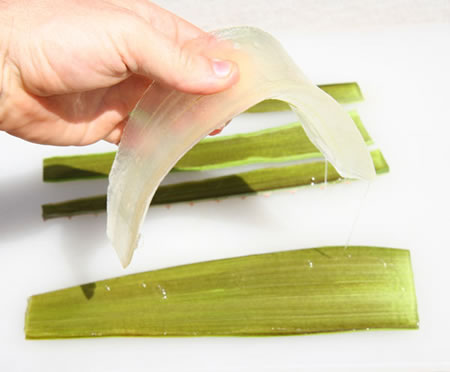
An Aloe Vera crop starts to yield commercially viable leaves from the second to fifth year.
The leaves are harvested 4 times a year. At each harvest, 3 leaves are cut from each plant. In total, each plant yields 12 leaves per year.
Uses of Aloe Vera
Claims about the therapeutic properties of Aloe Vera
Scientific evidence for the ornamental and medicinal properties of Aloe Vera is limited and often contradictory.
Nevertheless, the cosmetic and alternative medicine industry often refers to the soothing, moisturizing and healing properties of Aloe Vera, especially through internet advertisements. Aloe Vera gel is used as an ingredient in consumer products including lotions, yogurts, drinks and some sweets.
Aloe Vera juice is used to relieve heartburn and irritable bowel syndrome. The extracts and also the quantities used for these purposes seem to be non-toxic. It is common practice for cosmetic companies to add Aloe Vera juice or other derivatives of Aloe Vera to products such as make-up, moisturizers, soaps, sunscreens, incense, shaving foams and shampoos. Other uses of Aloe Vera derivatives include dissolving the semen of sheep for artificial insemination, preservative of fresh food and as an aid to water retention in crops.
The alleged therapeutic properties of Aloe are not limited to Aloe Vera alone but are also found to a greater or lesser extent in the gels of other plants of the family. In fact they are shared among a large number of the family “Asphodelaceae”. For example, the plant “Bulbine frutescens” is used to treat burns.
Aloe Vera has a long association with healing properties, although it is not known when it was made and if it was applied to medical science. The first evidence of the use of Aloe Vera appears:
- in the 16th century BC through the Egyptian Ebers scroll
- in the 1st century AD in the five-volume work of Pedaenius Dioscorides ‘On the Matter of Medicine’ and in the work of Pliny the Elder ‘Natural History’
- in the 6th century AD in the ‘Juliana Anicia Codex’, which was in fact an illustrated reproduction of the work of Pedaenius Dioscorides
Aloe Vera is non-toxic with no known side effects provided that the aloin has been removed by treatment. Taking Aloe Vera containing haloine in significant amounts has been associated with various side effects. Nevertheless, Aloe is used for its healing properties in the traditional medicines of China, Japan, Russia, South Africa, India, and America.
Aloe Vera can be effective in treating wounds. But the evidence in wound treatment is limited and contradictory. For example, some studies show that Aloe Vera accelerates wound healing, while conversely, some other studies show that where Aloe Vera gel was applied, wound healing was delayed compared to traditional ways of treating. A more recent study (2007), shows that Aloe Vera helps in healing first and second degree burns.
In addition to topical use on wounds and burns, internal use of Aloe Vera has been linked to improved blood glucose levels in diabetics and lower blood lipid levels in those with hyperlipidemia and even acute hepatitis. Preliminary research has shown that oral consumption of Aloe Vera gel can reduce symptoms and inflammation in patients with ulcerative colitis. Components extracted from Aloe Vera have been used as immunostimulants to help fight cancer in dogs and cats, but the treatment has not been tested in humans.
Topical applications of Aloe Vera may be effective in genital herpes and psoriasis. It has not been found to provide protection against sunburn (burns from excessive sun exposure) or burns from other sources of radiation .
From a clinical study, it was found that using toothpaste containing Aloe Vera reduces gingivitis and plaque. However, the same results were obtained by those who were treated with toothpaste containing fluoride.
Aloe Vera extracts may have antibacterial and antifungal activity which could potentially help treat minor skin infections. In one study, the inside in the leaves of Aloe Vera gel was shown to inhibit the growth of streptococcus and sigella in vitro.
Commercial uses
Aloe Vera has wide application on the face, where it is used as a moisturizer and anti-irritant. It is also used to rejuvenate head hair, by those who prefer natural products and is consumed by vegetarians.
Previous uses
Prior to 2003, aloin was a common ingredient in laxative products given over-the-counter in the US. In 2003, the FDA classified aloin as a Class III ingredient and thus banned its use in these products. It should be noted here that unprocessed Aloe Vera containing aloin is used as a laxative while the processed juice of Aloe Vera that does not contain significant amounts of aloin is used as a digestive system soother. Due to FDA regulations, manufacturers generally remove aloin from their products.
Side Effects
The use of Aloe Vera topically has not been associated with any significant side effects. However, based on a two-year toxicity study, oral consumption of an extract of whole green leaf Aloe vera leaf, there is clear evidence of carcinogenic activity on colon tumors in male and female mice. As far as is known so far, there is no evidence that a similar effect could occur in humans. However, more information is needed about different Aloe Vera products and how people use them in order to assess the potential risks.
Symptoms of diarrhoea and abdominal cramps from oral consumption of Aloe Vera have been reported.
Diarrhoea caused by the laxative action of Aloe Vera may reduce the absorption of medicines.
Those who have diabetes and are receiving treatment to lower blood glucose should be cautious about consuming Aloe Vera orally, because preliminary studies show that Aloe Vera can lower blood glucose levels.
There have been some cases of acute hepatitis from taking Aloe by mouth, but there is not enough evidence to make an absolute correlation.
Sources
Aloe Vera (Wikipedia)
Aloe Vera [NCCAM Herbs at a Glance]
Tags: ALOE • ALOE VERA • CULTIVATION

